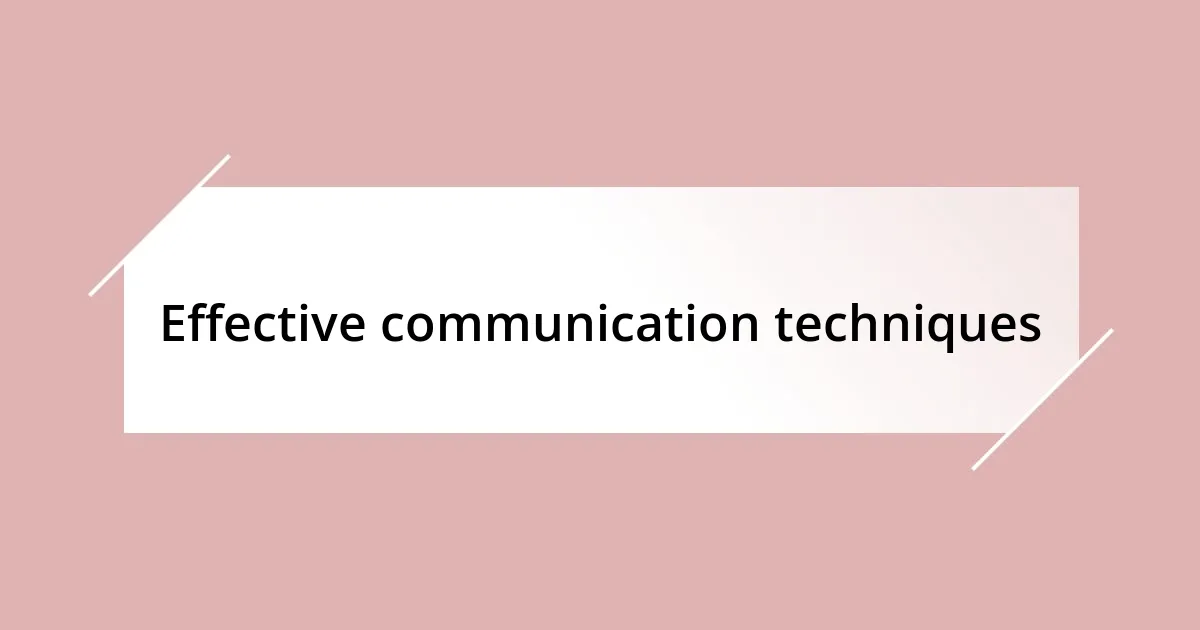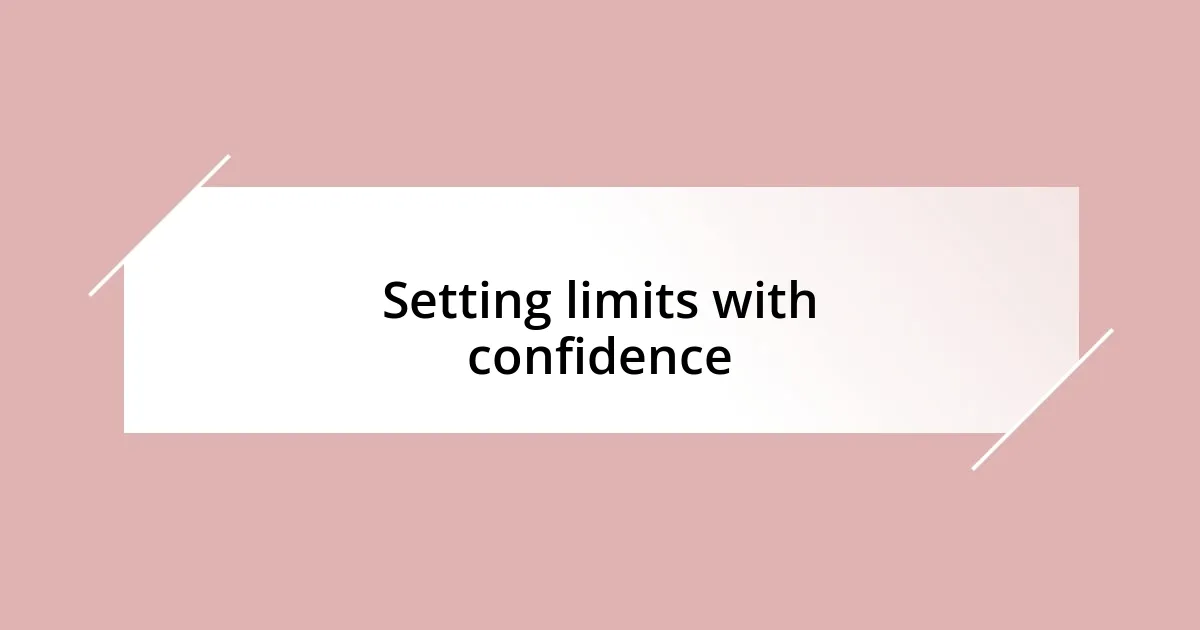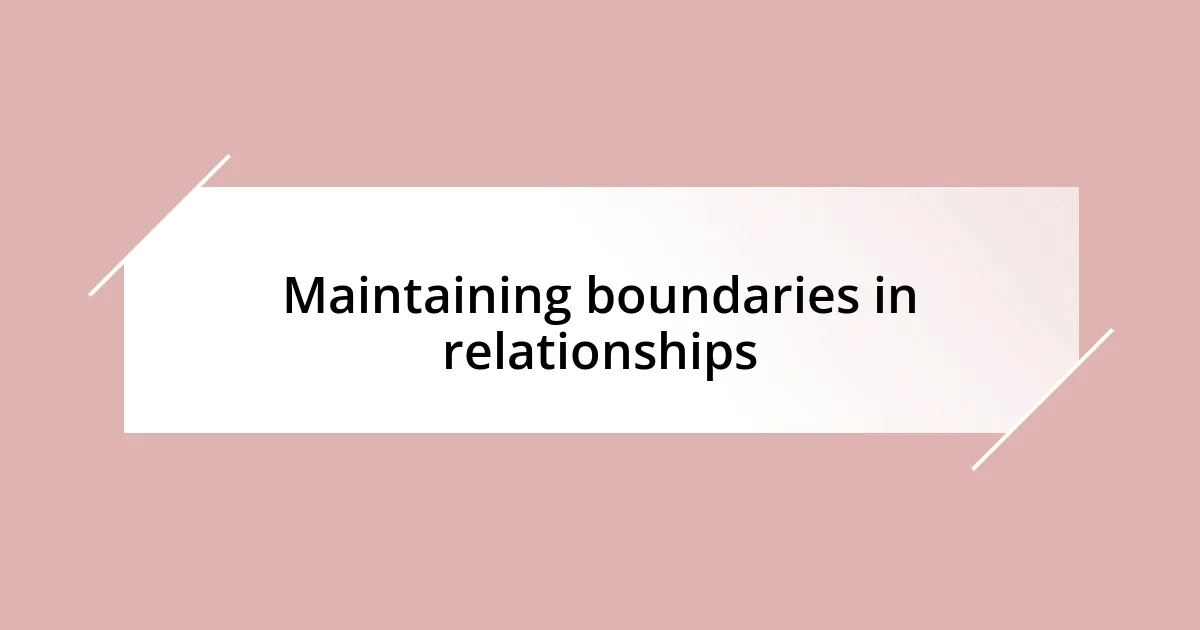Key takeaways:
- Understanding personal boundaries is essential for emotional well-being; they serve as a personal compass in relationships.
- Identifying and articulating boundary needs helps in maintaining healthier relationships and prioritizing self-care.
- Effective communication techniques, including clarity and active listening, are crucial for reinforcing boundaries and fostering understanding.
- Regularly reviewing and adjusting boundaries is necessary, as they evolve with individual needs and relationships over time.

Understanding the concept of boundaries
Boundaries are like invisible lines that define where one person ends and another begins. I remember the first time I truly understood this concept; I had a close friend who often crossed into my personal space—emotionally and physically. It felt suffocating at times, and that experience taught me the importance of establishing my own limits.
Thinking about boundaries, I’ve often wondered: what makes it so challenging for people to set them? In my experience, many of us fear confrontation or worry about disappointing others. I once hesitated to tell a colleague that their constant late-night messages were overwhelming me. It took a bit of courage, but setting that boundary not only alleviated my stress but also strengthened our professional relationship.
It’s fascinating how boundaries can differ among individuals. For instance, while I cherish alone time to recharge, my partner thrives in social environments. This variance highlights that boundaries aren’t one-size-fits-all; they should reflect our personal needs and comfort levels. Have you ever found yourself fluctuating between needing space and wanting connection? That’s the beauty of boundaries—they can evolve as we do, serving as a personal compass in our relationships.

Identifying personal boundary needs
Identifying my personal boundary needs was a journey filled with reflections and realizations. I vividly recall an instance when a friend would often call me late at night. Initially, I didn’t mind, but over time, those calls disrupted my sleep and left me feeling drained. This prompted me to reflect on my need for personal space during nighttime hours. By recognizing this pattern, I could articulate the boundary that best served me, paving the way for a healthier relationship.
In another situation, I found myself overwhelmed with social obligations. I’d automatically say “yes” to invitations without considering my actual feelings. The turning point came during a particularly busy week when I felt utterly exhausted. It was then that I realized the importance of acknowledging my limits and honoring my need for downtime. This experience taught me that my needs are valid and deserve to be voiced, even if it means disappointing someone occasionally.
As I learned to identify my boundary needs, I discovered that it’s essential to prioritize self-awareness. Each time I tuned into my feelings—like recognizing when I felt anxious or overwhelmed—I gained clarity on what boundaries I truly required. For anyone on a similar path, I suggest keeping a journal of these emotional insights. It’s a practical way to track your needs over time and develop a clearer understanding of what works best for you.
| Boundary Type | Personal Experience |
|---|---|
| Emotional Boundaries | Learned to communicate my need for personal space after feeling overwhelmed by constant questions about my feelings. |
| Time Boundaries | Realized the importance of saying “no” after noticing my energy levels depleting from too many social commitments. |

Recognizing boundary violators
Recognizing boundary violators can sometimes feel like spotting a hidden pattern in a complex puzzle. I remember a situation at work where a colleague consistently interrupted my tasks under the guise of wanting collaboration. While I value teamwork, his disregard for my focused time felt suffocating. It became clear that his behavior was more about his needs than respecting mine, pushing me to consider how often people might prioritize their agenda over my boundaries.
To identify these boundary violators in your life, observe how you feel in their presence. Here are some signs to look out for:
- Constant Intrusion: They frequently invade your personal space, physically or emotionally, without regard for your comfort.
- Disregard for Your Time: They encroach on your schedule, continuously asking for favors or expecting immediate responses.
- Emotional Overstepping: They make you feel guilty for prioritizing your needs, often dismissing your feelings.
- Inconsistent Communication: They reach out at odd hours without considering how it affects your personal time.
By staying attuned to these signs, I learned to be proactive about recognizing when my boundaries were being crossed. The process wasn’t always straightforward, but it was essential for cultivating relationships that respected my limits.

Effective communication techniques
When it comes to effective communication techniques, clarity is vital. I remember a time I needed to express my discomfort with how often my relatives would drop by unannounced. Instead of dancing around the issue, I was straightforward: “I really appreciate your visits, but I need a heads-up beforehand.” This direct approach not only made my feelings clear but also invited understanding rather than defensiveness. How often do we shy away from truthful conversations out of fear? Moving forward with honesty can lighten burdens we didn’t realize we were carrying.
Active listening plays a crucial role as well. I once had a friend who would share details about their life, but I often found myself distracted or formulating responses instead of truly listening. It struck me when they shared a concern about feeling unheard. It dawned on me that listening isn’t just about hearing words; it’s about engaging with the speaker’s feelings. This realization pushed me to consciously practice fully focusing on others during conversations. I found that asking questions not only shows interest but also invites the person to express themselves more deeply. Have you ever felt not listened to? That silence can feel just as loud as words.
Nonverbal cues are another fundamental part of communication that I’ve learned to embrace. I recall resolving a tense disagreement with a colleague by maintaining eye contact and using open body language, which conveyed sincerity and approachability. I noticed that when I crossed my arms or looked away, it felt like a wall had come up. Understanding that our body language speaks volumes helped shift the energy in that conversation, fostering a more open dialogue. Isn’t it fascinating how much our physical stances can influence interactions? It’s a subtle yet powerful reminder of the importance of being aware of how we present ourselves and react to others.

Setting limits with confidence
Setting limits with confidence often requires a shift in mindset. I can recall a moment when I felt overwhelmed by requests from friends to help with their projects on top of my own commitments. Instead of automatically saying yes, I took a breath and asserted, “I’m not able to take on more right now.” The relief I felt was instant. It taught me that saying no isn’t a rejection of others but an affirmation of my own needs.
Confidence in setting limits also comes from practice. I remember a particularly challenging conversation with my boss about workload. I prepared by jotting down my achievements and areas where I felt stretched too thin. When I spoke up, my clarity and preparation resonated with her. “I appreciate your support,” I said. It felt empowering to advocate for myself, and, surprisingly, it opened up a productive discussion about how to prioritize our team’s goals without sacrificing individual well-being.
Self-reflection is crucial in this journey. After a difficult interaction with a boundary violator, I took time to evaluate my emotions and reactions. Why did that conversation fray my nerves? I realized that acknowledging my feelings not only clarified my limits but also reinforced my resolve to articulate them confidently in the future. Have you ever noticed how revisiting past experiences can illuminate your growth? It’s a reminder that each conversation is a stepping stone towards stronger self-advocacy.

Maintaining boundaries in relationships
Maintaining boundaries in relationships isn’t just about setting them—it’s about consistently reinforcing them. I vividly recall a situation where a close friend would often call me late at night for help with personal dilemmas. Initially, I felt honored that they turned to me, but it soon became overwhelming. So, I gently explained, “I value our late-night chats, but I need to rest earlier to function well the next day.” Expressing this not only preserved my well-being but also strengthened our bond by showing respect for my limits.
I’ve learned that checking in with myself regularly is essential for keeping those boundaries intact. After a weekend gathering where I felt my boundaries being tested, I took a moment to reflect. Did I assert myself enough? I realized I needed to communicate my availability more clearly moving forward. It’s like recalibrating my internal compass. Have you ever felt the need to reassess how your time and energy are being spent? It’s crucial to acknowledge that boundaries require ongoing maintenance—much like a garden that needs to be tended to thrive.
Additionally, I find it beneficial to encourage open conversations about boundaries with others. During one heartfelt discussion with a family member, I shared my feelings about always being the one to initiate plans. To my surprise, they echoed similar sentiments, feeling pressured to fit into my schedule. This exchange made me realize that boundaries are a two-way street, fostering understanding and respect. Isn’t it refreshing when honesty not only uplifts your spirit but also strengthens connections? By creating a space for dialogue, I’m not just setting boundaries, but I’m also nurturing the relationship itself.

Reviewing and adjusting boundaries
Reflecting on my boundaries has been an enlightening journey. I distinctly remember a period where I allowed my schedule to be dictated by others’ needs. It hit me during a particularly exhausting week when I realized I had not left time for my own priorities. In those moments of reflection, I asked myself—what truly matters to me? That introspection led to necessary adjustments, guiding me to prioritize my commitments without guilt.
Adjusting boundaries is not a one-time event but a continuous process. After a frustrating situation where my time was continually overlooked, I decided to have a candid conversation with a colleague. We discussed how expectations were clashing, and I clearly laid out my availability. “I need to focus on my projects during the day,” I stated firmly. It was interesting to see how this dialogue opened the floodgates for further discussions, enabling both of us to navigate our responsibilities with mutual respect.
I believe that openness about boundaries can also evolve with time. For instance, during a recent family gathering, I noticed certain topics recurring that made me uncomfortable. I took a chance and shared this with my relatives. To my surprise, what followed was a compassionate dialogue where others expressed similar feelings. It made me realize—why do we hesitate to address discomfort within our loved ones? Our relationships blossomed as we adjusted our boundaries together, creating an environment where everyone felt safer and heard.













